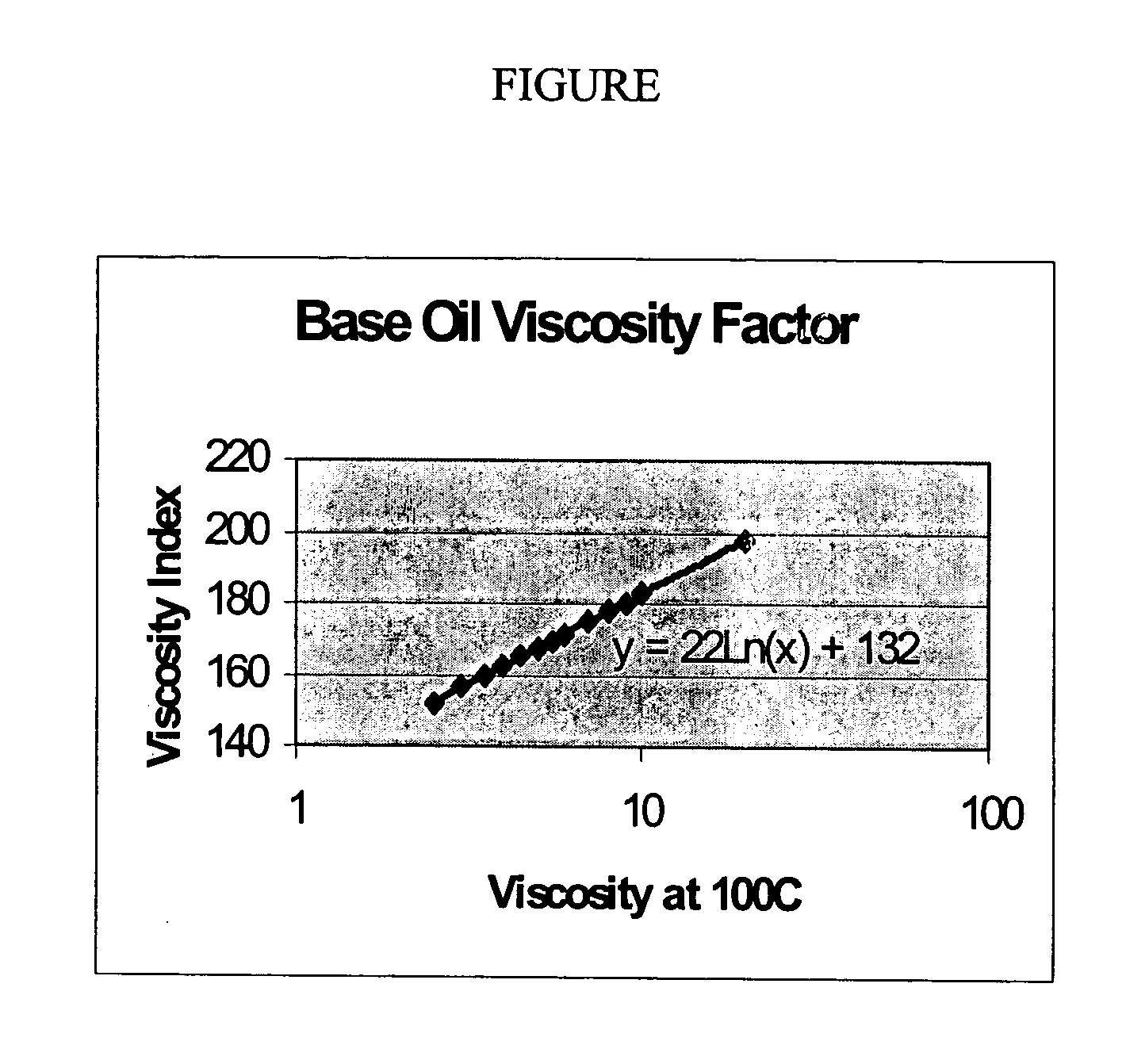Processes for producing lubricant base oils with optimized branching
a technology of lubricant base oil and optimized branching, which is applied in the direction of hydrocarbon oil treatment products, petroleum chemical modification, lubricant composition, etc., can solve the problems of large branching, less than optimal viscosity index of hydroisomerization products, and waxy character of normal paraffins,
- Summary
- Abstract
- Description
- Claims
- Application Information
AI Technical Summary
Benefits of technology
Problems solved by technology
Method used
Image
Examples
example 1
Example 1 produced a lubricant base oil made from n-C28 feed (purchased from Aldrich) using a Pt / SSZ-32 catalyst (0.3 wt % Pt) bound with 35 wt % Catapal alumina. The run was at 1000 psig, 0.8 LHSV, and 7 MSCF / bbl once-through H2. Reactor temperature was 575° F. The effluent from the reactor was subsequently passed over a Pt—Pd / SiO2—Al2O3 hydrofinishing catalyst at 450° F. and, other than temperature, the same conditions were used as in the isomerization reactor. The yield of 600° F.+ product was 71.5 wt %. The conversion of the wax to 600° F.− boiling range material was 28.5 wt %. The conversion below 700° F. was 33.6 wt %. The bottoms fraction from the run (75.2 wt %) was cut at 743° F. to give 89.2 wt % bottoms (67.1 wt % on the whole feed). The properties of the hydroisomerized oil bottoms are summarized below in Table I:
TABLE IHydroisomerized Oil Bottoms PropertiesPour Point, ° C.+3NMR AnalysisC2 Branch0.26C3 Branch0.2C4 Branch0.26C5+ Branch0.97Internal Ethyl0.09Sum1.78NMR B...
example 2
An n-C36 feed (purchased from Aldrich) was isomerized over a Pt / SSZ-32 catalyst which contained 0.3% Pt and 35% Catapal alumina binder. Run conditions were 580° F., 1.0 LHSV, 1000 psig reactor pressure, and a once-through hydrogen rate of 7 MSCF / bbl. The reactor effluent passed directly to a second reactor, also at 1000 psig, which contained a Pt / Pd on silica-alumina hydrofinishing catalyst. Conditions in that reactor were a temperature of 450° F. and LHSV of 1.0. Conversion and yields were as summarized below in Table II:
TABLE IIConversion <650° F., Wt %32.2Conversion <700° F., Wt %34.4Yields, Wt %C1-C20.45C3-C45.16C5-180° F.6.22180-350° F.7.40350-650° F.13.23650° F.+68.09
The bottoms fraction from the run was isolated. The properties of the hydroisomerized oil bottoms are summarized below in Table IIII:
TABLE IIIHydroisomerized Stripper Bottoms PropertiesSim. Dist., LV %, ° F.IBP / 5677 / 74710 / 30801 / 9045091470 / 90920 / 92595 / FBP927 / 929Pour Point, ° C.+20
The stripper botto...
example 3
A hydrotreated Fischer-Tropsch wax was isomerized over a Pt / SSZ-32 catalyst, which contained 0.3% Pt and 35% Catapal alumina binder. Run conditions were 560° F., 1.0 LHSV, 300 psig reactor pressure, and a once-through hydrogen rate of 6 MSCF / bbl. The reactor effluent passed directly to a second reactor, also at 300 psig, which contained a Pt / Pd on silica-alumina hydrofinishing catalyst. Conditions in that reactor were a temperature of 450° F. and LHSV of 1.0. Properties of the hydrotreated Fischer-Tropsch wax are summarized below in Table IV. Conversion and yields, as well as the properties of the hydroisomerized stripper bottoms are summarized below in Table V.
TABLE IVInspections of Hydrotreated Fischer-Tropsch Wax (951-15-431)Gravity, API40.3Nitrogen, ppm1.6Total sulfur, ppm2Sim. Dist., Wt %, ° F.IBP / 5512 / 59110 / 30637 / 7085076470 / 90827 / 91195 / FBP 941 / 1047
TABLE VIsomerization of FT Wax over Pt / SSZ-32 at560° F., 1 LHSV, 300 psig, and 6 MSCF / bbl H2Conversion <650° F., Wt %15.9Co...
PUM
| Property | Measurement | Unit |
|---|---|---|
| wt % | aaaaa | aaaaa |
| pour point | aaaaa | aaaaa |
| kinematic viscosity | aaaaa | aaaaa |
Abstract
Description
Claims
Application Information
 Login to View More
Login to View More - R&D
- Intellectual Property
- Life Sciences
- Materials
- Tech Scout
- Unparalleled Data Quality
- Higher Quality Content
- 60% Fewer Hallucinations
Browse by: Latest US Patents, China's latest patents, Technical Efficacy Thesaurus, Application Domain, Technology Topic, Popular Technical Reports.
© 2025 PatSnap. All rights reserved.Legal|Privacy policy|Modern Slavery Act Transparency Statement|Sitemap|About US| Contact US: help@patsnap.com


